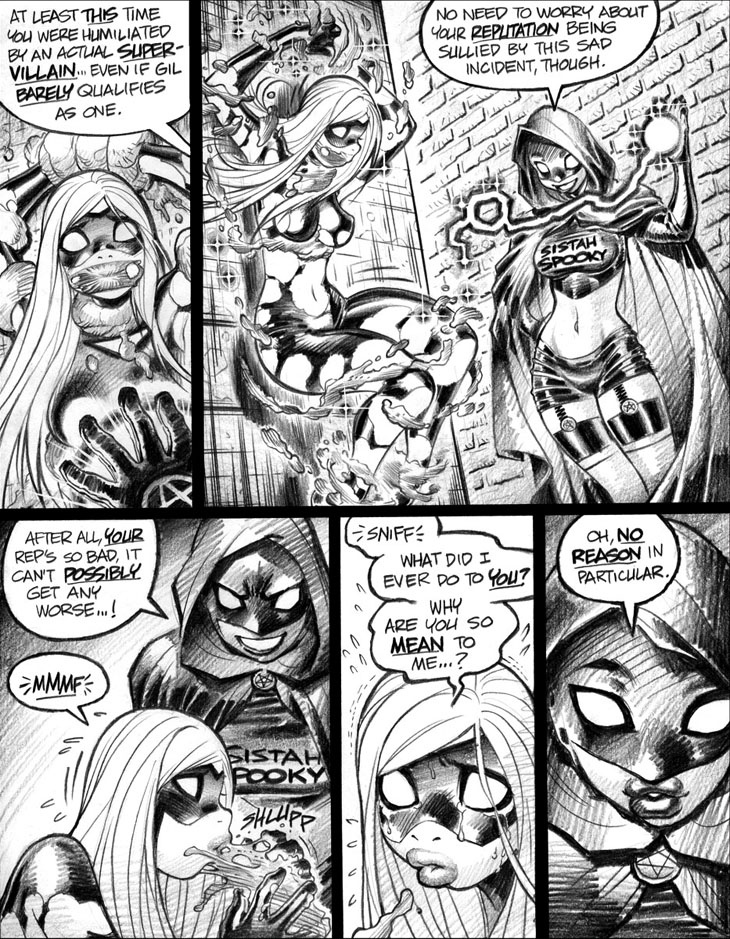My previous commentary mentioned the questionable logistics behind how the supervillain Glue Gun Gil might have adhered Emp to that wall, which led to a brief discussion of so-called “elliptical storytelling,” in which the narrative pops into or out of scenes with little more than a hand-waving dismissal of the logistics involved—or no explanation whatsoever. Then again, an elliptical approach to narrative is especially useful for scenes in which Emp gets damsel-in-distressed as, otherwise, the arduous process of showing how she wound up in that state would be messy and time-consuming. For example, I’ve often had to use duct tape to wrap insulation around plumbing, and even that task has proved fairly challenging at times; trying to wrap duct tape around a grown-ass adult who does not wish to be taped would, one suspects, be considerably more clumsy and difficult. (In fact, a more realistic depiction of duct-tape application could make for an amusing—if sloppy—bit of physical comedy. Damsel-in-distress slapstick, ahoy!)
Along those lines, a surprising number of folks don’t realize that the use of chloroform, as depicted in fiction, is a technically unrealistic dramatic trope. The familiar riff of “chloroform-soaked rag clamped over struggling damsel’s face for 3-4 seconds, then she passes out for half an hour or more” is, of course, not how the application of general anesthesia works. (In fact, in the real world, people have been accidentally killed by chloroform misuse based on this pop-culture myth.) The trope is just a time-saving means to quickly end a scene on a dramatic note, and establish that the heroine has fallen into the bad guys’ clutches. Theoretically more realistic alternatives are not only more time-consuming—or panel-consuming, in a comics context—but unappetizing, as the heroine would otherwise have to be threatened with bodily harm or beaten into submission, which most writers haven’t cared to depict.
And I do mean “heroine,” by the way, as chloroforming is almost always the “damselized” equivalent of the old and similarly unrealistic “pistol-whipped from behind” trope that so often used to plague male heroes. Damsels get chloroformed into slumber with a dainty “mmph” or two, while men of action—such as gritty private eyes sticking their noses where they shouldn’t—get clubbed conveniently unconscious with a single sharp, crisp rap on the noggin.
Side note: On the chloroform front, I draw your attention to the commentary for a page from the earlier story “All Mine,” in which my random decision to trope-swap in a more recent anesthetic, the compound “halothane,” drew the ire of a fiercely loyal community of chloroform fetishists. (This, in turn, led to the creation of a supervillain named “ChloroforMaster,” who won’t be disturbing naive and sheltered readers until Empowered vol. 3.)
Interesting, by the way, that manga and anime used to feature a peculiar variant trope for incapacitating a hapless heroine. That is, a bad guy would haul off and give a dainty damsel a punch in the stomach, to which she would respond with a ladylike gasp and then pass out into a state of helpfully carryable unconsciousness. (Dunno if you’ve ever been punched in the stomach, but that’s not a typical reaction. Then again, not like the fictional use of chloroform or a snooze-inducing pistol-whip to the head is any more realistic.) I assume this was done because, once again, this probably seemed more palatable to writers than depicting a pretty girl getting knocked the f**k out with with a bad guy’s right hook. (Note, by the way, that I have no compunctions whatsoever about showing an action heroine getting knocked the f**k out.) Gotta say, though, I’ve only ever seen this old “belly-punch” J-pop trope a few times, and the last occasion was probably 20-odd years ago; good ol’ American-style chloroforming seems to have replaced this localized idiosyncrasy in manga and anime. USA! USA!
Now, here’s the thing. I’d love to have Emp address the peculiar gender issues inherent to feminized forms of incapacitation within a story, but there’s a slight problem: Chloroforming (or knockout belly-punching) of a heroine is, as we’ve seen, actually a completely fictional trope. Can’t call it out on grounds of realism—or lack thereof—because it is, in fact, impossible to begin with. Now, Meta-Textual Emp could certainly decry the trope’s sexism, but in-universe Emp would have a harder time complaining about it, since choloroforming and KO belly-punching and slumber-inducing konks on the head are all fictional concepts that don’t exist in real life—or, at least, don’t exist in the same story-convenient manner. Anesthetic overdoses and traumatic brain injuries are very real things, sure, but they have little or relation to the narrative devices based on them. Oh, well.
-Adam Warren

